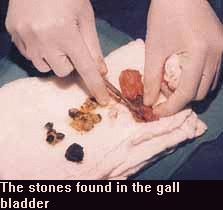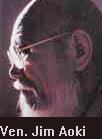

![]()
She was a well built woman of thirty six, a gem cutter from Kalutara. For four long years she had suffered an excruciating pain on her right lower abdomen. She came to Sri Jayewardenepura Hospital, a physical wreck and the surgeon after tests discovered that her gall bladder was full of stones, ‘‘not gems’’ added the consultant surgeon Gamini Goonetilleke.
For almost a hunderd years, said Dr. Goonetilleke the standard for treating disease of the gall bladder, especially one with gall stones which are cholesterol stones, was to remove the gall bladder with a long incision below the ribs on the abdominal wall. It was a messy operation with a great deal of blood loss and a long stay in hospital. Now with the development of laparoscopic surgery, the operation is as easy as an appendicitis operation and the patient can go home the next day. There is hardly any blood loss.
Our gem cutter was given general anaesthesia by the chief anaesthetist Savitri Wijesekera.
Laparoscopic cholecystectomy is a new procedure adopted today. It is a procedure whereby the diseased gall bladder together with the stones is removed through a small incision not more than one cm. ’’This is also called ‘minimal access surgery’ or in layman’s language ‘Keyhole surgery’," said Dr. Goonetilleke. This was a technique first introduced in France and today used in most countries which practise advanced surgical methods.
There are obvious advantages such as a small incision which is naturally conducive to better cosmetic results than an ugly long scar on the surface of the abdomen. There is much less pain and the patient can leave for home the very next day.
The surgeon with scalpel makes a small incision and three tiny little cuts on each side of the abdomen and at the bottom, near the navel.
Imagine, the surgeon then introduces carbon dioxide through a needle into the abdominal cavity to distend it, so that the organs inside can be visualised easily. The introduction of gas is carefully monitored and the pressure, volume and rate are regulated electronically by hightech machines handled by the anaesthetists.
A naso gastric tube is introduced and an endotrachial tube is introduced through the mouth.
A light source called laparoscope with a camera attached to it is next introduced into the abdominal cavity through one of the incisions. This enables the surgeon and his surgical team to see a clear picture of the abdominal organs on the television monitor.
Next the surgeon introduces a series of long delicate instruments which can be seen on the screen. One of them, I remarked to Dr. Goonetilleke looked like a crocodile’s snout and he replied that it was called the ‘crocodile forceps’. It clutches and pulls at the gall bladder and one can see it all reflected on the screen. The surgeon after introducing these delicate instruments through the small holes in the abdomen starts on the operation proper. The cystic duct connecting the gall bladder to the bile duct is clipped and the cystic artery which is in the lower part of the gall bladder and leading to the liver is also clipped.
It is here that the skill of the surgeon is seen, there has to be precise hand-eye co-ordination.
 One
can see on the screen the surgeon gently separating the gall bladder from its
attachment to the liver and after freeing it, it is taken out through the 1cm
opening which was slightly enlarged when the surgeon found there was a very
large stone too embedded in the gall bladder.
One
can see on the screen the surgeon gently separating the gall bladder from its
attachment to the liver and after freeing it, it is taken out through the 1cm
opening which was slightly enlarged when the surgeon found there was a very
large stone too embedded in the gall bladder.
A suction tube is introduced as a preccautionary method to suction out any blood in the abdomen. Also the diathermy probe is used to burn any bleeding points.
The mushy, fleshy gall bladder was taken out. One of the young doctors dissected it and there inside lay four yellow small stones, four black small stones and one large black stone.
The surgeon Dr. Gamini Goonetilleke was quite chirpy after such a delicate operation and was getting ready to operate on a woman 32 years old with hernia. He said all patients with gall stones should be offered this procedure in view of the many advantages.
Continued the doctor he does not know why the Creator made man has a gall bladder, a troublesome organ, when one can live quite comfortably without it.
The thirty-six-year old gem cutter with one child, a daughter, would the next day have gone back to her and, to her job as a gem cutter.
‘The Sunday Times’ thanks the operating team chief nurse Hewa Vissa and nurses Kumudu and Renuka, Doctor assisting Gnage Jeevaithan chief anaesthetist Savitri Wijesekera and Dr. Upendra Jayasena. Our thanks to the consultant surgeon of course Dr. Gamini Goonetilleke.
 An
exhibition of paintings using computer technology and bronze sculptures by the
Ven. Dr. Jiun Aoki, will be held at the National Art Gallery from August 26-29.
An
exhibition of paintings using computer technology and bronze sculptures by the
Ven. Dr. Jiun Aoki, will be held at the National Art Gallery from August 26-29.
The exhibition, part of a project undertaken by the Jiun International foundation, a non-profit, non- governmental organisation to promote computer art among the conventional artists in Sri Lanka, is the second such exhibition to be held in the country by this world renowned artist. The exhibition will be inaugurated by Minister of Cultural and Religious Affairs Lakshman Jayakody on August 25, at 6.30 pm.
This unique exhibition which will exhibit more than 60 of Ven. Dr. Jiun Aoki’s creations will be open to the public from 10 am to 7 pm from August 26-29. Entrance will be free. The other guests at the opening will be Prof. W. D. Lakshman, Prof. V. K. Smaranayake, Dr. R. A.Ariyaratne, Prof. J. B. Dissanayake, Dr. Ranjith Kabral and many other distinguished guests.
All paintings at the exhibition are created using a technique which is new to Sri Lanka, said Chandana Nugegodage, Director of Jiun International Foundation. Laser effects and special lighting techniques are used to create depth and three dimensional effects in the paintings.
Conventional artists are reluctant to use computers to produce their work as they do not associate it as a medium of artistic expression,Mr. Nugegodage said.
In addition to being an artist of modern abstract Ven. Jiun is also a sculptor, composer, calligrapher, writer and poet.
Continue to Plus page 6 - Helping children: Iman’s model act
Return to the Plus contents page
![]()
| HOME PAGE | FRONT PAGE | EDITORIAL/OPINION | NEWS / COMMENT | BUSINESS
Please send your comments and suggestions on this web site to
info@suntimes.is.lk or to
webmaster@infolabs.is.lk